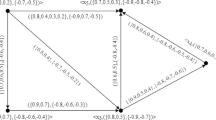Abstract
In this paper, we extend the method of optimizing the similarity (OS method for short) of truth tables used in fuzzy reasoning, to intuitionistic fuzzy reasoning. In this regard, we introduce intuitionistic fuzzy implicators and some intuitionistic similarity measures. We explain the OS method for intuitionistic fuzzy modus ponens and intuitionistic fuzzy modus tollens. Then, we define continuous intuitionistic fuzzy implicators and give some weaker conditions under which the optimization problem has a solution. The reductive property and optimality condition for this method are investigated.



Similar content being viewed by others
References
Atanassov K (1989) Interval valued intuitionistic fuzzy sets. Fuzzy Sets Syst 31:343–349
Atanassov K (1986) Intuitionistic fuzzy sets theory. Fuzzy Sets Syst 20:87–96
Atanassov K (2012) On intuitionistic fuzzy sets theory. Springer, Berlin
Atanassov K (2016) Review and New Results on Intuitionistic fuzzy Sets, Mathematical Foundation of Artificial Intelligence, Sofia, 1988, Preprint IM-MFAIS- 1 -88. Reprint: Int. J. Bioautomation, 20, S1, S7-S16
Bustince H, Burillo v, Mohedano V (2002) About intuitionistic fuzzy implicators, In: Caulfield HJ, Chen S, Chen H, Duro R, Honavar V, Kerre EE, Lu M, Romay MG, Shih TK, Ventura D, Wang PP, Yang Y (eds) Proceedings of 6th joint conference on information sciences, 36, pp 109–112
Chen SM (1988) A new approach to handling fuzzy decision-making problems. IEEE Trans Syst Man Cybern 18:1012–1016
Chen SM (1994) A weighted fuzzy reasoning algorithm for medical diagnosis. Decis Support Syst 11:1012–1016
Cignoli R, Dottaviano IML, Mundici D (2000) Algebraic foundations of many-valued reasoning. Kluwer Academic Publishers, Dordrecht
Cornelis C, Deschrijver G, Kerre EE (2004) Implication in intuitionistic fuzzy and interval-valued fuzzy set theory: construction, classification, application. Int J Approx Reason 35:55–95
Deng G, Jiang Y (2014) Fuzzy reasoning method by optimizing the similarity of truth-tables. Inf Sci 288:290–313
Deschrijver G, Cornelis C, Kerre EE (2003) Class of intuitionistic fuzzy t-norms satisfying the residuation principle. Int J Uncertain Fuzziness Knowl Based Syst 11(6):691–709
Deschrijver G, Cornelis C, Kerre EE (2004) On the representation of intuitionistic fuzzy \(t\)-norms and t-conorms. Fuzzy Sets Syst 12(1):45–61
Dubois D, Prade H (1991) Fuzzy sets in approximate reasoning. Fuzzy Sets Syst 40(1):143–244
Esteva F, Godo L (2001) Monoidal t-norm based logic: towards a logic for left-continuous t-norms. Fuzzy Sets Syst 124:271–288
Fuller R (1998) Fuzzy reasoning and fuzzy optimization, Turku centre for copmuter science, Department of Operations Research, Eotvos Lorand University, Budapest, pp 173-193
Fuller R, Zimmermann HJ (1993) Fuzzy reasoning for solving fuzzy mathematical programming problems. Fuzzy Sets Syst 60:121–133
He YS, Quan HJ (2012) Study on the results of triple I method. Comput Sci 39:248–250
Hung WL, Yang MS (2008) On similarity measures between intuitionistic fuzzy sets. Int J Intell Syst 23:364–383
Intarapaiboon P (2014) New similarity measures for intuitionistic fuzzy sets. Appl Math Sci 45:2239–2250
Li HX (1998) Interpolation mechanism of fuzzy control. Sci China (Ser E) 41:312–320
Luo MX, Yao N (2013) Triple I algorithms based on Schweizer - Sklar operators in fuzzy reasoning. Int J Approx Reason 640–652:54
Mamdani EH, Gaines BR (1981) Fuzzy reasoning and its applications. Academic Press, London
Rudin W (1976) Principles of mathematical analysis, 3rd edn. McGraw, New York
Turksen IB, Zhong Z (1988) An approximate analogical reasoning approach based on similarity measures. IEEE Trans Syst Man Cybern 18:1049–1056
Turksen IB, Zhong Z (1990) An approximate analogical reasoning scheme based on similarity measures and interval valued fuzzy sets. Fuzzy Sets Syst 36:323–346
Wang DG, Meng YP, Li HX (2008) A fuzzy similarity inference method for fuzzy reasoning. Comput Math Appl 56:2445–2454
Wang GJ (1999) On the logic foundation of fuzzy reasoning. Inf Sci 117:47–88
Wang GJ (1999) The full implication triple I method of fuzzy reasoning. Sci China (Ser E) 29:43–53
Yeung DS, Tsang ECC (1997) A comparative study on similarity-based fuzzy reasoning methods. IEEE Trans Syst Man Cybern 27:216–227
Yeung DS, Tsang ECC (1994) Improved fuzzy knowledge representation and rule evaluation using fuzzy Petri nets and degree of subsethood. Intell Syst 9:1083–1100
Zheng M, Shi Z, Liu Y (2014) Triple I method of approximate reasoning on Atanassovs intuitionistic fuzzy sets. Int J Approx Reason 55:1369–1382
Zadeh LA (1965) Fuzzy sets. Inf Control 8:338–353
Zadeh LA (1973) Outline of a new approach to the analysis of complex systems and decision processes. IEEE Trans Syst Man Cybern 3:28–44
Zadeh LA (1975) The concept of a linguistic variable and its application to approximate reasoning, Parts 1–3. Inf Sci 9:43–80
Zadeh LA (2009) Towards extended fuzzy logic-A first step. Fuzzy Sets Syst 160:3175–3181
Author information
Authors and Affiliations
Corresponding author
Ethics declarations
Conflict of interest
The authors thereby that they have no conflict of interests.
Additional information
Communicated by V. Loia.
Publisher's Note
Springer Nature remains neutral with regard to jurisdictional claims in published maps and institutional affiliations.
Rights and permissions
About this article
Cite this article
Esmaeili, M., Eslami, E. Intuitionistic fuzzy reasoning using the method of optimizing the similarity of truth tables. Soft Comput 23, 8765–8774 (2019). https://doi.org/10.1007/s00500-018-3478-1
Published:
Issue Date:
DOI: https://doi.org/10.1007/s00500-018-3478-1




